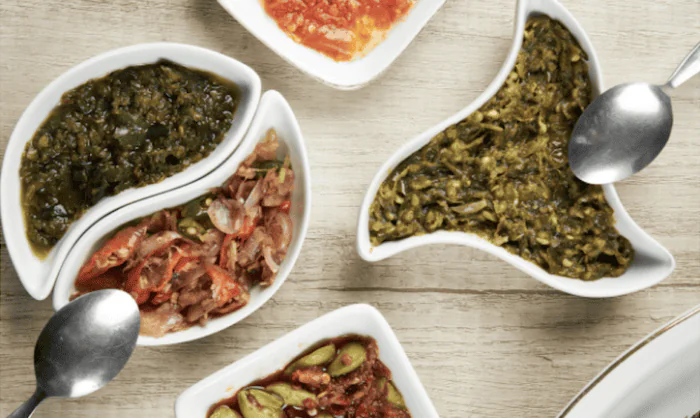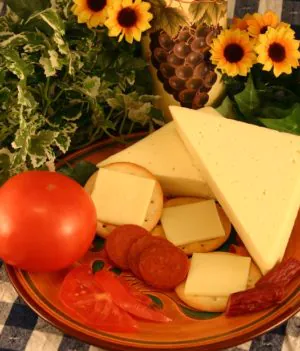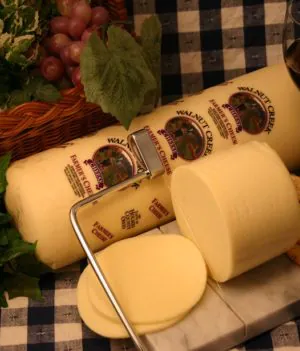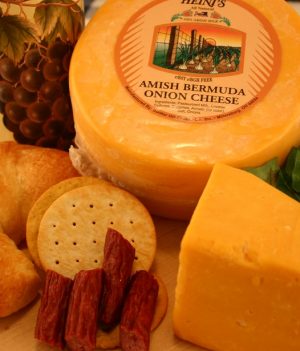Search Results for: smoked cheese
The Best Sides With Boneless Smoked Ham
The Best Sides With Boneless Smoked Ham
Make a classic festive meal with our list of the best sides with boneless smoked ham. Nothing screams holiday time louder than juicy, tender ham. Well, maybe turkey does, but they’re both pretty festive.
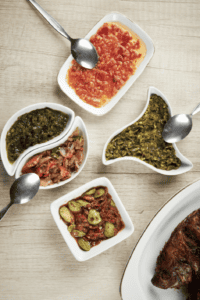
9 Ideas for Sides with Boneless Smoked Ham
Here’s a list of what we think goes really well with our boneless smoked ham:
- Garlic mashed potatoes: Boil potatoes with garlic until tender, then mash with butter and milk for a creamy texture—season with salt and pepper.
- Roasted Brussels sprouts with balsamic glaze: Toss Brussels sprouts in olive oil, salt, and pepper, then roast until crispy. Drizzle with a homemade balsamic glaze made by reducing balsamic vinegar and honey.
- Honey-glazed carrots: Steam or boil carrots until tender, then toss in a simple glaze made with melted butter and honey. Season to taste.
- Crispy roasted sweet potatoes: Cube sweet potatoes, toss them with olive oil, paprika, salt, and pepper, and roast at a high temperature until crispy and tender.
- Green bean almondine: Steam or blanch green beans, then sauté them in butter with sliced almonds and a splash of lemon juice.
- Cranberry sauce: Simmer fresh cranberries with sugar, orange juice, and zest until the berries burst and the sauce thickens.
- Buttered corn on the cob: Boil corn until tender and drizzle with melted butter, seasoning with salt and pepper.
- Cheese and herb stuffing: Combine cubed bread, shredded cheese, sautéed onions, sage, and chicken broth, then bake until golden and crispy.
- Garlic bread: Spread a mixture of softened butter, garlic, and parsley on French bread, then bake until golden and fragrant.
How To Reheat Boneless Smoked Ham for Christmas
Homemade Cheese Pizza
This easy 3-step homemade cheese pizza recipe is the perfect crowd-pleaser and will soon become a firm favorite in your home.
In this article, we share the elements that go into making a great homemade cheese pizza, the ingredients and steps to making one, and then a few ideas for toppings, should you want to elevate your pizza to Gourmet status!
If you’re into homemade cheesy recipes, take a look at our post about The Best Grilled Cheese Recipe.
What goes into a homemade cheese pizza?
There are 5 key components that you’ll need to make a homemade cheese pizza:
- Dough: A good pizza starts with a good dough. The dough should be light and airy with a crispy crust that is neither too thick nor too thin. The dough should be allowed to rise correctly in the refrigerator or at room temperature to achieve the perfect texture.
- Sauce: The tomato sauce is a critical component of the pizza, and choosing a high-quality tomato sauce with a balanced flavor is essential. The sauce should not be too sweet or acidic and should be applied sparingly to avoid making the pizza soggy.
- Cheese: Cheese is perhaps the most important ingredient in a cheese pizza. Mozzarella is the classic choice for pizza, but other cheeses, such as Cheddar or Provolone, can also be used. The cheese should be grated fresh and spread evenly over the pizza to ensure every bite has a cheesy goodness.
- Toppings: Toppings are a matter of personal preference, but the key is to use fresh, high-quality ingredients.
- Seasonings: A great homemade cheese pizza is incomplete without some seasonings to enhance the flavors. A drizzle of olive oil, a sprinkle of sea salt, and a dash of dried oregano or basil can add delicious flavor to your pizza.
How to make homemade cheese pizza
Ingredients
- 1 pound pizza dough (homemade or store-bought)
- 1 cup tomato sauce
- 2 cups shredded Mozzarella cheese
- 1/4 cup grated Parmesan cheese
- 1 tablespoon olive oil
- Salt and pepper to taste
Instructions
- Roll out the pizza dough to your desired thickness and shape on a lightly floured surface. Transfer the dough to a lightly greased pizza pan or baking sheet.
- Spread the tomato sauce evenly over the dough, leaving about 1/2 inch of space around the edges; sprinkle the shredded mozzarella cheese over the tomato sauce, and then sprinkle the grated Parmesan cheese on top.
- Drizzle the olive oil over the pizza, and then season with salt and pepper to taste. Bake the pizza in the preheated oven (450°F (230°C) for 12 to 15 minutes, or until the crust is golden brown and the cheese is melted and bubbly. Remove the pizza from the oven and let it cool for a few minutes before slicing and serving.
Topping ideas for homemade cheese pizza
If you want to use your cheese pizza as a foundation, here are a few ideas for additional toppings:
- Caramelized onions, our Sweet Fire Goat Cheese, pistachios, and arugula
- Glacier Wildfire Blue Cheese, Streb Meats Fresh Cut Smoked Bacon, and torn fresh basil
- Parmesan, roasted red bell peppers, and anchovies
- Artichokes, roasted oyster mushrooms, and Gruyere
Wrapping it up
We hope this post inspires you to make your own homemade cheese pizza! All the cheeses mentioned in this post are available on our Cheese Products Page.
The Best Grilled Cheese Recipe
The Best Grilled Cheese Recipe
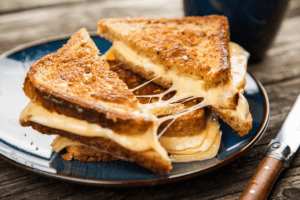
Grilled cheese is a beloved classic comfort food for many people around the world, and there are many reasons why it has earned such a devoted following. One reason is that it is incredibly easy and quick to make, requiring only a few simple ingredients and minimal preparation. It’s a dish that can be made at home, in a dorm room, or even on a camping trip with just a few basic supplies.
Grilled cheese sandwiches evoke a sense of nostalgia and comfort for many people. Childhood memories of after-school snacks, mom’s grilled cheese, and lazy Sunday mornings can all be associated with this classic sandwich. As such, it has a special place in many people’s hearts and can bring about feelings of warmth and contentment.
What goes into the perfect grilled cheese?
The perfect grilled cheese sandwich is a combination of several elements that come together to create a harmonious and delicious flavor and texture profile. The following are some key components that go into making the best grilled cheese:
- Bread: The bread used, should be sturdy enough to hold the filling without falling apart or getting too soggy. Many people prefer a bread with a crispy crust and a soft interior, such as sourdough or French bread.
- Cheese: The type of cheese used is a matter of personal preference, but it should be a variety that melts well and has a rich flavor. Cheddar, Gouda, Swiss, and provolone are all popular choices.
- Butter: The butter used for grilling the sandwich should be unsalted and at room temperature so that it spreads easily onto the bread. Some people also like to use mayonnaise or olive oil for a different flavor.
- Temperature: The heat of the skillet or griddle should be medium-low so that the sandwich has time to cook evenly without burning.
- Cooking Time: The sandwich should be cooked for 2-3 minutes on each side, or until the cheese is fully melted and the bread is golden brown and crispy.
- Additional ingredients: While a classic grilled cheese is simply bread and cheese, some people like to add extras like bacon, tomato, avocado, or caramelized onions for a unique twist.
- Cheese Melting Techniques: To achieve the perfect melt, grating the cheese rather than slicing it can deliver a more even and quicker melt.
Steps to making the best grilled cheese
Making the perfect grilled cheese sandwich involves several key steps that come together to create a delicious and satisfying meal. Here’s how to do it right:
- Buttering the bread: The first step in making a grilled cheese sandwich is to butter the bread. Take two slices of bread and spread a generous amount of unsalted butter on one side of each slice. This will help the bread to toast and become golden brown while also adding a rich, buttery flavor to the sandwich.
- Cheese selection and preparation: The type of cheese used is a matter of personal preference, but it should be a variety that melts well and has a rich flavor. Grate or slice the cheese and evenly distribute it over one of the buttered slices of bread. If you are adding any additional ingredients, now is the time to layer them on top of the cheese.

- Grilling the sandwich: Place the other slice of bread on top of the cheese and press down gently to create a sandwich. Heat a skillet or griddle over medium-low heat and place the sandwich onto the surface. Cook for 2-3 minutes on each side, or until the cheese is fully melted and the bread is golden brown and crispy. To ensure even cooking, you can press down on the sandwich gently with a spatula while it is cooking.
- Additional ingredients or variations: While a classic grilled cheese is simply bread and cheese, you can add a variety of additional ingredients or variations to create a unique and flavorful sandwich. Some popular options include adding cooked bacon, sliced tomato, avocado, caramelized onions, or a sprinkle of herbs or spices.
Pro Tips To The Perfect Grilled Cheese
Grilling the perfect grilled cheese sandwich is all about getting the right temperature, timing, and cheese melting techniques. The following are some tips for achieving grilled cheese success:
- Temperature: To ensure that the sandwich cooks evenly and does not burn, it’s important to cook it over medium-low heat. This will give the bread enough time to toast and become golden brown without burning. If the heat is too high, the bread will burn before the cheese has had a chance to melt.
- Time: The cooking time for a grilled cheese sandwich should be 2-3 minutes on each side, or until the cheese is fully melted and the bread is golden brown and crispy. It’s important not to rush the cooking process by turning up the heat or flipping the sandwich too often. This can result in uneven cooking and a sandwich that is not fully melted or toasted.
- Cheese melting techniques: To achieve the perfect melt, many people prefer to grate their cheese rather than slicing it. This allows the cheese to melt more evenly and quickly. Another technique is to cover the skillet or griddle with a lid while the sandwich is cooking. This traps the heat and helps the cheese to melt more quickly and evenly.
- Experiment with Cheese Varieties: While cheddar cheese is a classic choice for a grilled cheese sandwich, there are countless other cheese varieties to try. Some popular options include Gouda, Swiss, provolone, mozzarella, or a combination of different cheeses. Each type of cheese will bring its own unique flavor and texture to the sandwich.
- Add Crunch with Ingredients: If you want to add a crunchy texture to your grilled cheese sandwich, try adding ingredients like bacon, crispy onions, or thinly sliced apples. These ingredients will add a satisfying crunch and extra flavor to the sandwich.

Wrapping it up
A grilled cheese sandwich is a classic comfort food that has been enjoyed for generations. With the right ingredients and techniques, it’s easy to create a perfectly toasted and melted sandwich that is satisfying and delicious.
By following the steps outlined in this blog post, you can create a grilled cheese sandwich that is sure to please any cheese lover.
Whether you prefer a classic grilled cheese or like to experiment with different cheeses and ingredients, these tips will help you achieve grilled cheese greatness. So, go ahead and give it a try – your taste buds will thank you!
Fall Recipe: Pumpkin Shaped Cheese Ball
It’s the week of Halloween. The leaves are eerily falling and the temperature is too. Get in the “spirit” of the season with this pumpkin shaped cheese ball that is sure to wow your Halloweekend guests!
Cheese of the Month: Havarti
We are continuing our Cheese of the Month posts today! We will share with you some of our favorite cheeses to eat throughout the seasons, some ideas for eating them and even wine pairings so that you can make a party of it.
February’s cheese of the month is…
Havarti!
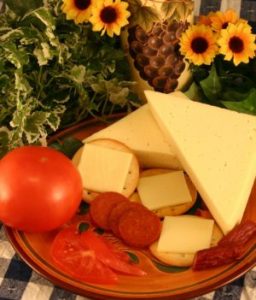
What is Havarti Cheese?
Havarti Cheese or Cream Havarti (Fløde Havarti in Danish) is a semi-soft Danish cow’s milk cheese. It is rindless, with a smooth surface and a cream or yellow color depending on the type. It has very small and irregular eyes (holes).
It has a buttery aroma and a generally sweet taste with a slightly acidic tang. It can be sharp in the stronger varieties, resembling Swiss cheese.
We also stock Havarti with Dill and Havarti with Caraway for those looking for additional flavor. Dill combines the flavors of fennel, anise, and celery, with a slight bitterness, whilst caraway has a very pungent, earthy anise flavor.
How is Havarti Cheese made?
Havarti cheese was initially created by Hanne Nielsen who operated an experimental farm called Havarthigaard, in Øverød, north of Copenhagen, in the mid-19th century. It is made like most cheeses, by introducing rennet to milk to cause curdling. The curds are pressed into cheese molds which are drained, and then the cheese is aged. Havarti is a washed curd cheese, which contributes to the subtle flavor of the cheese.
It will usually be aged for around three months. As it ages it becomes saltier and nuttier.
How should I eat it?
Havarti is a table cheese that is suitable for slicing, grilling, or melting. When left at room temperature the cheese tends to soften quickly so it is great on a cheeseboard alongside hard cheeses.
It is delicious melted into pasta dishes including macaroni cheese or incorporated into a grilled cheese sandwich. Havarti even works well when grated onto a pizza with mozzarella. You can make an excellent cheese sauce with it that will pair well with grilled chicken and vegetables.
Because of its creaminess, it stands up well to spice. You can use it in recipes that call for chilies and it also pairs very well with the heat of horseradish. Try Havarti with Dill in cauliflower dishes for a fun combination of tastes.
If you are serving it as part of a cheeseboard, slice a few thin slices off the block to show your guests that this is a fantastic way to enjoy it. Serve it with fresh fruits and honey, as well as savory crackers and cured meats. Try our Streb Meats Fresh Smoked Sausage as a starting point.
What should I drink with this cheese?
The smooth, creamy flavor of Havarti goes well against most red wines. It can stand up to the high alcohol flavors of Zinfandel or Shiraz, but it is subtle enough to enjoy with a soft Merlot or Cabernet Sauvignon. If you prefer white wine, try a Sauvignon Blanc or Riesling, as the fruity flavors of both will complement the butteriness of the cheese. You could even try it with a light weiss beer or saison.
Do you like Havarti Cheese? Let us know in the comments!
Cheese Glossary: The Letter S
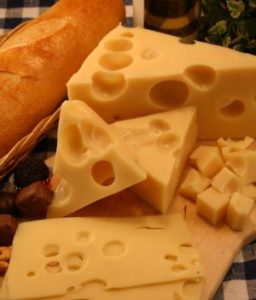
Salting
The process of adding salt to cheese! Salt can be added when the cheese is still in curd form or it can be rubbed on after the cheese is pressed, depending on which cheese it is. A salt solution can also be used. This is known as brining. Whilst some of the flavor of cheese is achieved through salting, the process also preserves the cheese.
Semi-hard
Cheeses vary from hard to soft based on their body and texture. Cheddar and Swiss are examples of semi-hard cheeses.
Semi-soft
Semi-soft cheeses are usually made from whole milk and melt when heated.
Sharp
A flavor term referring to the fully developed flavor of aged cheeses. Cheeses that might be sharp include Cheddar, Provolone and blue-veined cheeses like Danish Blue.
Smoked
Smoked cheese is produced in a similar way to smoked meats. There are various ways to do this including adding smoking over wood or adding liquid smoke to brine. We stock a wide variety of smoked cheeses.
Soft
Cheeses with a high moisture content. They are usually set with the addition of lactic acid cultures and include cheeses such as cottage cheese, mascarpone, and ricotta.
Soft-ripened
These cheeses, such as Brie and Camembert, have a thin white or cream rind that is soft and edible. They are usually soft inside and have a luscious, creamy texture.
Stabilizer
An ingredient added to products, including cheese, to improve consistency and texture.
Starter
A culture that normally has varying percentages of lactic acid, bacteria or mold spores, enzymes or other microorganisms and natural chemicals. Starter cultures control the process of curdling milk during cheesemaking by converting lactose to lactic acid. They can also give the cheese particular flavor and characteristics.
Stirred-curd Cheese
These are sometimes called granular cheeses. They are made in a similar way to cheddar cheese but do not go through the cheddaring and milling process. It tends to have a higher moisture level than other cheeses. The granular aspect comes from the open look to the
cheese.
Stretched
Cheeses that have stretched curds are kneaded with hot water, which gives them a fibrous structure. The most common example would be mozzarella.
Surface-ripened
Cheeses that ripen from the outside in when a mold, yeast or bacteria is applied to the surface.
Swiss
A holey, semi-hard cheese with a creamy color, Swiss cheese has a nutty, slightly piquant flavor whilst simultaneously being somewhat creamy. The process of making Swiss cheese involves natural bacteria consuming the lactic acid in the cheese. This releases carbon dioxide gas, which forms bubbles that become the holes in the cheese. These are often referred to as “eyes”.
We hope that you continue to enjoy our cheese glossary!
American Cheese – The Complete Guide

America’s love for CHEESE is known to the world! Not only as top manufacturers but also as the highest cheese consumers, Americans seem to have aced the taste and mastered the art of all things cheese. The United States offers hundreds of varieties and styles of cheese perfectly crafted to cater to global cuisines and satiate the palates of customers across the globe. Be it a burger, pizza, or pasta, it is incomplete without a great-tasting cheese.
But where did so much love for cheese come from? If history is anything to go by, Americans have inherited their passion for cheese-making and relished it from their ancestors. Nevertheless, over the past decades and centuries, American cheese has undergone an immense transformation. It has changed not only in terms of the manufacturing process but also in terms of variety. From its taste and texture to its packaging and supply, everything has only improved over the years. Let’s find out where it all began. Ready to buy some of your own cheese? Check out our selection!
History of American Cheese
The process of cheese-making dates back to the era when most of the Americans preferred to make it at home, either to consume at home or to sell in the local market. During this time, a variety of European styles persisted in non-commercial cheese-making. However, American industry soon caught up with the manufacturing process and mastered the skill of one type – Cheddar, which went on to become one of America’s most popular cheeses. Cheddar, subsequently, became a common man’s cheese, so much so that Americans simply called it ‘yellow cheese’ or ‘store cheese’.
The United States saw its first cheese revolution in 1851 when Jesse Williams created the first cheese factory in New York. A few decades later, in 1903, James L. Kraft moved to Chicago from Canada and started wholesaling cheese. Slowly came in the concept of processed cheese and cheese singles or slices. Today, considering the amount of cheese that is manufactured in the U.S., it has become the best suited source for the global cheese supply.
Cheddar Cheese

The yellow-orange American cheddar caught the fancy of Americans in the 19th century, which continues today. Cheddar cheese remained the most popular and favourite cheese for the longest time, and currently is the second-favourite after mozzarella with consumption of around 9.6 pounds per capita in 2014, which rose to 11.07 per capita in 2017, as stated by the United States Department of Agriculture.
Although cheddar cheese has a texture similar to its counterparts, what gives it the yellow-orange tinge that differentiates it from the rest? Being milk products, usually, all types of cheese are white or sometimes light yellow, depending upon the milk used. But cheddar is orange. Why? That’s surely not the original colour of the milk it is made from, right? The colour is instead derived from the flavourless Annatto seeds, which are extracted from the tropical Achiote tree. That is what gives Wisconsin cheddar its yellow-golden-orange tinge.
Manufacturing
Interestingly, cheddar cheese gets its name from the process of ‘cheddaring’ during manufacturing. To begin with, the curd and whey are separated using rennet – an enzyme. Then comes cheddaring; an additional step, especially followed to prepare cheddar cheese. Here, after heating, the curd is kneaded with salt, and the whey is drained by cutting it into small pieces, stacked and turned. Vintage cheddar, commonly known as mature or “sharp” cheddar is matured for 15 months or more. The cheese requires special facilities to be kept at a constant temperature. Some cheddar cheese is even matured in the caves.
Cheese : Health Benefits

Contrary to what many people think, cheese is healthy and a great source of calcium, high-quality protein and fat. It contains a good amount of vitamin A and vitamin B12. Additionally, it offers other nutrients like phosphorus, zinc and riboflavin. Cheese, if made of 100% grass-fed animals, is one of the richest sources of various nutrients, which also contains vitamin K2 and omega-3 fatty acids. Fat-soluble vitamins such as vitamin A are retained in the curd at the time of the manufacturing process. This makes cheese a wholesome food.
Cheese is almost essential for good bone health. Calcium helps to maximize peak bone mass and promote rapid skeletal growth to reduce the risk of osteoporosis during late adulthood.
Let’s read about various health benefits cheese has to offer :
This happens to be the primary concern for most of the people who give up cheese – weight gain. However, there is no reason to give up on something that does not necessarily cause weight gain. A wide variety of cheeses of varied calorie and fat content are available in the market. All you need to do is switch to a low-calorie cheese, and you will be fine! Naturally, low-fat cheeses like part-skim mozzarella, cottage cheese or ricotta can be your best bet. Keeping in mind the current trend, US cheese manufacturers have started producing lower-fat cheeses that are low in calories without compromising on the quality, taste, texture and colour.
Moreover, consuming calcium-rich dairy products is consciously becoming a common food habit. Hence, including cheese in your diet may help immensely towards controlling body weight. It can help obese adults to lose bodyweight or body fat when it is eaten as a part of a reduced-calorie diet. According to clinical trials, those who take three to four servings of milk, cheese or yogurt a day while on a low-calorie diet tend to lose more weight and gain more lean muscle mass compared to those who abstain from dairy products.
Cheese reduces the risk of various dental ailments like cavities; it may protect against root cavities, and dental problems commonly found among adults. Additionally, consuming cheese in between meals or snacks may be a good way to ward off tooth decay. Dental cavities are a result of the breakdown of tooth enamel when there are acid-forming dental plaque bacteria that ferment starch and dietary sugar. This process is known as demineralization. Hence, if remineralisation occurs at a faster rate than demineralization, it preserves the quality of teeth for a much longer period. Research has proven that cheese not only prevents acid demineralization of tooth enamel but also supports remineralisation of minor cavities.
Believe it or not, various studies say that cheese has anti-cavity properties. Some varieties of cheese that promote good dental health are Swiss, Blue, Brick, Monterey Jack, Brie, Aged Cheddar, American Processed Cheese, Mozzarella and Gouda.
Moreover, frequent consumption of cheese stimulates the flow of saliva, which has properties to reduce/fight cavities. The protein, calcium and phosphorus present in cheese help neutralize acids and thereby prevent tooth decay. American Dental Association and American Academy of Pediatric Dentistry (AAPD) recommend cheese as a nutritious snack for children and young adults.
According to Dietary Guidelines for Americans, consumption of dairy products is associated with reduced risk of cardiovascular diseases in adults. Although cheese is a source of saturated fat, research findings have doubts about the role of saturated fat in increasing cardiovascular diseases. On the contrary, studies have suggested that dairy products like cheese have a beneficial effect on the heart and its overall health. In comparison to butter, cheese is believed to lower the low-density lipoprotein cholesterol (LDL) and increase high-density lipoprotein cholesterol (HDL). Cheese, when taken in moderation, can help to reduce risk factors for heart diseases like hypertension atherosclerosis (hardening of the arteries), and blood clots. .
Dietary patterns such as DASH – Dietary Approaches to Stop Hypertension can help further. It is a low-fat diet which includes three servings of dairy foods a day, for instance, regular low-fat cheeses, yogurt and low-fat or toned milk. Cheese may also have a beneficial role in reducing metabolic syndrome, which is responsible for cardiovascular diseases and type 2 diabetes.
When it comes to children, cheese can serve as one of the best snacks – healthy, nutritious and filling at the same time. Especially when you are travelling, the various on-the-go varieties of cheese like sticks, slices/singles, cubes and shreds are quite convenient to carry. Cheese consumption in moderation with the meal or as a snack for children is common in the US. It not only provides energy and nutrients required for proper growth and development, but also supports bone health, protects teeth from cavities and lowers body fat.
Gastrointestinal symptoms or problems such as diarrhoea and bloating are usually caused by lactose intolerance. Lactose is one of the principal carbohydrates present in the milk. When the lactose in the milk products is not digested completely, it causes a disturbance in intestine resulting into gastrointestinal symptoms. However, if you think that eating cheese is one of the leading causes for your indigestion, you need a reality check!
Many varieties of cheese – hard as well as natural like cheddar, Colby, Swiss, Monterey jack, etc. contain very little or no lactose at all. Additionally, it has been studied that all those who have been lactose intolerant can consume aged cheeses without any difficulty in digestion. In fact, the American Academy of Paediatrics, the National Medical Association and the 2010 Dietary Guidelines for Americans recommend aged cheeses for all those who suffer from lactose intolerance.
Various Styles of Cheese

- Block
- Barrel
- Loaf
- Daisy
- Wheel
- Moon
- Longhorn
- Cubed & crumbled
- Slices, singles, grated, shredded
- Stringed cheese
Types of Cheese based on Popularity
Here are the popular varieties of cheeses available in the US market and consumed by Americans.
- Cheddar
- Colby
- Cream Cheese
- Monterey Jack
- Mozzarella
- Pasteurised Processed Cheese
- Reduced Fat Cheeses
- Ricotta
- Shredded Cheeses
- Swiss
Types of Cheese based on the Degree of Hardness
The cheeses mentioned above are based on popularity and consumption. Now, let’s see the types of cheese based on the degree of hardness – from soft, creamy cheese to hard, grated cheese and powders. This too is a common way of organising cheese varieties :
Soft-Fresh Cheeses
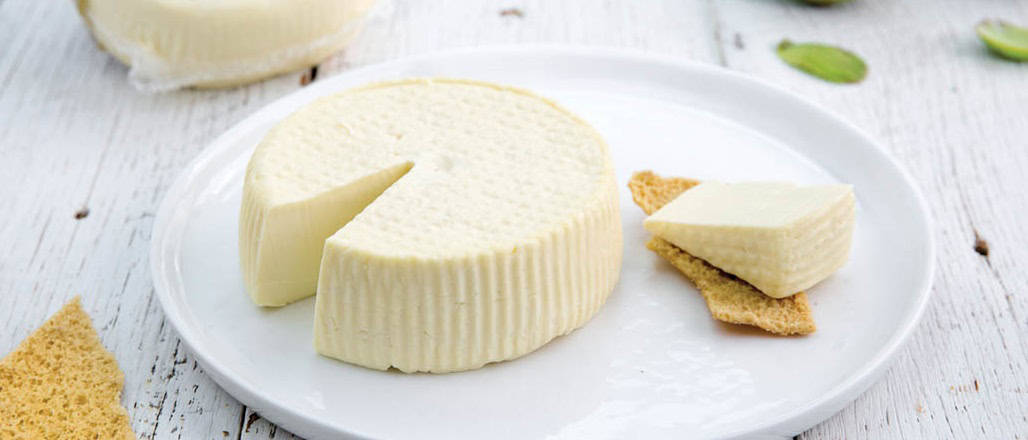
- Cottage cheese
- Cream cheese – plain & flavoured
- Feta
- Mascarpone
- Neufchâtel – plain & flavoured
- Queso Blanco
- Ricotta – whole milk, low-fat, fat-free
Soft-fresh cheeses are mainly referred to as acid-set or direct-set. Manufacturing these cheeses includes coagulation of milk with lactic acid, lemon juice, vinegar or a similar acid that is directly added to the milk, instead of rennet and enzymes. Later, the whey is drained from soft cheeses using gravity rather than mechanical pressure. This gives the cheese its velvety texture and higher moisture content. Many soft cheeses are packed in tubs, without being cut, pressed into a form or aged. The moisture content in such types of cheeses is the highest, which make them excellent ingredients for fillings and spreads. They are made from top-quality US milk and have a mild, delicate and creamy flavour.
As mentioned above, soft-fresh cheeses make for great cheese spreads, dips and fillings due to their flexible texture. Use to toss in the salad, dip your favourite bites, sprinkle on your salad or use it as pasta/ravioli fillings – soft-fresh cheese never disappoints. The naturally salty feta cheese goes well with the bland vegetables in the salad. Also, these cheeses are excellent binders often used to put together various ingredients. Additionally, the low-fat and no-fat versions are great options to explore for those who are on restricted diets.
Soft Ripened Cheeses

- Brie (single, double and triple cream and flavoured)
- Camembert
Soft ripened cheeses get their identity from the white mould that forms the outer rind. The mould allows the cheese to ripen from the outside as seen when cutting such type of cheeses. The area closer to the rind softens first and becomes semi-liquid while the centre is firmer and creamier, at times. The more ripened the cheese, the softer the texture, with distinct aroma and flavours.
Such types of cheeses are perfect for cheese platters and even cold appetizers. The soft-ripened cheeses in the US are made from pasteurised milk, ensuring high-quality, and are safe for consumption.
Semi-Soft Cheeses

- Brick, dry
- Washed-rind
- Colby jack
- Fontina
- Havarti
- Limburger
- Monterey jack
- Muenster
- Pepper jack
Semi-soft cheeses are always made with whole milk and never with part-skim milk. Some manufacturers prefer to add cream in the process. The entire process, especially the main ingredient – whole milk is responsible for the soft, creamy texture and excellent melting ability. Semi-soft cheese can be further categorized into dry-rind and washed-rind. Washed-rind cheeses are surface-treated with a bacterial smear and then washed with a solution to encourage the smear to grow. Washed-rind cheeses ripen from the outside in. Dry-rind cheeses are cured without a surface treatment. Semi-soft cheeses can be cubed, shredded, sliced and melted. They have some stretch, and they can be broiled and browned.
Semi-soft cheeses have great melting ability, and this makes them suitable for soups, sauces, casseroles and roulades. They easily blend with any other cheese as well as with various ingredients to make a delicious pizza sauce. The sliced forms are ideal for sandwiches and wraps.
Blue-veined Cheese

- Blue cheese
- Gorgonzola, creamy & crumbly style
Various blue moulds are added directly to the milk. Stainless steel needles are used to pierce the body of the cheese to allow oxygen in and carbon dioxide out of the interior, enabling the mould to thrive. If the cheese has been in vacuum packaging for some time, it will appear almost entirely white. The cheese will start turning its colour to blue as soon as the bag is removed.
Crumble into salads, use them in dressing, soups or sauces, the blue cheeses give you a perfect reason to whip up a tasty gourmet. And the credit goes to its soft, creamy texture and unique taste that goes well with most of the American foods.
Gouda & Edam
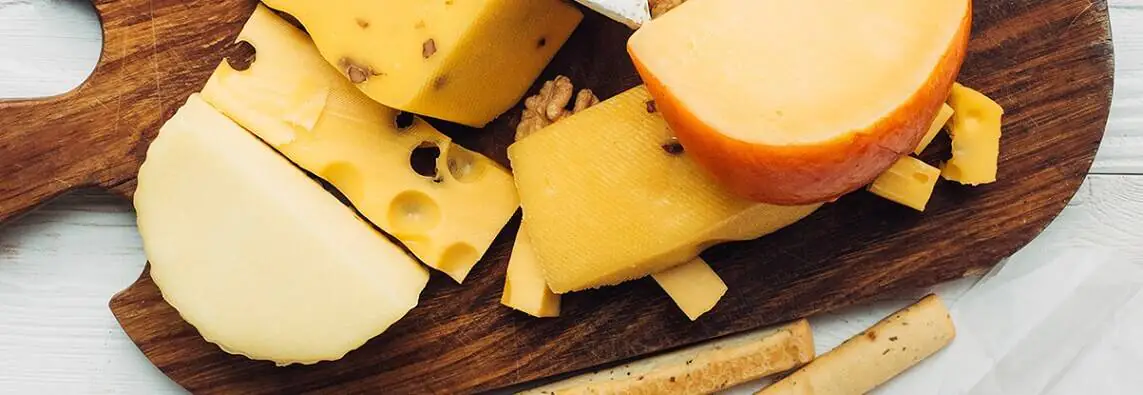
- Gouda
- Smoked gouda
- Edam
The manufacturers use specific starter cultures and only the highest quality milk to produce these ‘sweet-curd’ cheeses. The primary difference is that gouda is produced with whole milk, while edam is made with part-skim. Various herbs and spices are added to the curd to get flavoured gouda cheese.
Prepare sauce, soups, dips from them or use them as slices. Gouda is available in different flavours while edam slices can be used in sandwiches, burgers or wraps. It is also a popular choice for gourmet pizza sauces.
Pasta Filata Cheeses

- Fresh mozzarella
- Individually Quick Frozen mozzarella (IQF)
- Low-moisture, part-skim mozzarella
- Low-moisture, whole milk mozzarella
- Part-skim mozzarella
- Provolone, mild, aged and smoked
- Pizza cheese
- String cheese
- Whole milk mozzarella
These cheeses are named for the unique process of pulling the curds while they are dipped in hot water. They are prepared from the curd similar to semi-soft and firm cheeses. It involves warming of the milk and adding starter cultures and enzymes. After heating and stretching the curd, it is moulded. If it is mozzarella cheese, the moulded cheese is immersed in cold water, cooled in brine and packaged soon after.
Pasta filata cheeses are highly used in salads, sandwiches, au gratins and stuffing for snack bites. The ability to melt is what makes them a favourable cheese. String cheese has recently gained popularity among children. These cheeses can be sliced, shredded and cubed, hence flexible to use in various gourmet preparations.
Processed Cheese

- Pasteurized processed cheese
- Pasteurized processed cheese food
- Pasteurized processed cheese spread
- Pasteurized processed cheese product
- Cold-pack
Processed cheese is manufactured by mixing and heating natural cheese. However, the heating temperature varies according to the final product to be made – processed cheese, processed cheese food or processed cheese spread. Also, the moisture and fat levels differ according to the type.
Processed cheeses are very common when it comes to usage and consumption. They are used as cheese snacks, soups and sauces, cheese-stuffed entrees, sandwiches, baked goods, vegetables in cheese sauce, meat preparations and casseroles. Low-fat or fat-free types of processed cheeses are ideal for people on a diet to make fat-free soups, sauces, appetizers and various other baked starters.
Hard Cheeses

- Asiago
- Parmesan
- Romano
- Pepato
Hard cheeses are manufactured in many ways. The curd is cut much smaller than cheddar. Later, it is cooked at a higher temperature than other cheeses. Eventually, this gives a curd that has much drier texture compared to its counterparts. The curd is then pressed and either brined or dry salted, which is turned and rubbed with vegetable oil regularly.
Hard cheeses have a longer shelf life as they have lesser moisture content. Hence, they can be stored for a longer time. The grated version is widely used in several gourmet preparations. These cheeses are quickly browned on direct heating. Their more intense cheese flavour makes them ideal for crackers, popcorn, chips, pasta & pizza toppings, sauces and dips.
We have discussed almost all the main types of cheeses available and manufactured in the US. Apart from these, there are some more varieties like Swiss, Colby, cheese powders, cheese for special needs and speciality cheeses.
America : World’s Largest Cheese Producer
Being the largest cheese producer of the world, the cheese industry in the US is internationally recognized for its excellence and innovation. If numbers are anything to go by, almost a quarter of the world’s cheese (5.1 million metric tons in 2014) is manufactured in the United States alone.
Just in the past decade, cheese production has been increased by 1.1 million metric tons. American-made cheese not only excels in quality but also in styles and varieties to meet the demand of consumers across the world.
From food connoisseurs to common men, American-made cheeses seem to dominate the kitchens and palates of everyone! Now that we know what makes it rule the roost in taste and health, we can definitely say CHEEEEEESE! Aloud… and this time not for a selfie but for the stomach!
Cheese Glossary: The Letter F
The cheese glossary continues with the letter F!

Farmer’s cheese
Farmer’s Cheese is a mild, unripened white cheese made by adding rennet to cow’s milk. When the milk coagulates it separates into solid curds and liquid whey, which is drained off. The result at this stage is sometimes referred to as pot cheese. Further pressing out of the moisture results in a more firm and crumbly Farmer’s Cheese. It is often used in recipes including Blintzes and Pierogies. One popular local use is to lightly fry Farmers Cheese and eat it in a sandwich, but our favorite is to slice it very thin and roll it with our flavorful smoked meats. It is also known as a cheese that has fewer calories and less fat and cholesterol than many other cheeses.
Farm-made
This means a cheese that has been made on a farm with that farm’s own milk. If you have a chance to try a farm-made cheese it can often offer a specific taste unique to that area. This is also called farmhouse, farmstead, or fermier cheese.
Fermentation
The process of converting carbohydrates to alcohol or organic acids using microorganisms including bacteria and yeasts. In cheese, the carbohydrates are converted to organic acids.
Fermented
This can be used to describe the smell of cheese as having the quality of fermented alcohols.
Feta
A Greek cheese made from goat’s and sheep’s milk. It is a fresh cheese that is usually sold submerged in brine. It has a salty, tangy taste and a high moisture content. It is often used in salads and combines well with fruit, but can also be baked.
Finish
This can refer to several things:
- The ripening process involved in cheesemaking. Finishing methods include spraying the surface with Penicillium, washing rinds or turning the cheese.
- The packaging of cheese. This might include hard, natural rind, a bandage of cheesecloth and wax or vacuum packaging.
- The aftertaste of cheese, just as ‘finish’ is used in descriptions of wine.
Firm
Cheese varieties which are relatively inelastic and unyielding in texture. Firm cheeses include Cheddar and Romano Pecorino.
Force Ripening
Speeding up the ripening of a cheese by using a warmer environment than normal to naturally ripen the cheese or by changing the enzymes added.
Formaggio
The Italian word for cheese!
Fresh
Typically these are cheeses that have not been aged or cured. They usually have a delicate, tangy flavor from the lactic curdling. Fresh cheeses can be better for melting as they have so much moisture. These include Ricotta and Mascarpone. Some cheeses that are described as ‘fresh’ have been cured for a very short time, such as Feta.
Friable
This means a cheese that crumbles easily.
Fromage
The French word for cheese!
Fruity
A description of the sweet, fragrant aroma or flavor of some cheeses.
As always, let us know if you have any questions or words for us to define in the cheese glossary in the comments below.
Swiss Cheeses: Learn About Our Range
We stock a whole range of different Swiss cheeses here at Shisler’s Cheese House, so we thought now would be a great time to share them all with you.

How are Swiss Cheeses made?
The process of making Swiss cheeses involves natural bacteria consuming the lactic acid in the cheese. This releases carbon dioxide gas, which forms bubbles that become the holes in the cheese. These are often referred to as “eyes”.
Our range of Swiss cheeses
Our Ohio Swiss cheese is an Amish cheese made in Northeastern Ohio. It undergoes a longer aging process that it undergoes, at a higher temperature than younger cheeses. This produces larger eyes, which is sometimes seen as an indicator for better flavor. It closely resembles the original Swiss Emmental Cheese, which was originally produced in the Swiss canton of Bern. Ours has the signature nutty, bittersweet taste. The milk used in our Swiss cheese does not have preservatives added and is always from cows that have not been given hormones or antibiotics.
We also offer Baby Swiss, which substitutes water for the milk’s whey to slow the bacterial action. This creates smaller holes and a milder flavor, whilst still being delightfully creamy. If you or someone you love likes Baby Swiss cheese, then you’ll be pleased to know we offer a gift box with a 4lb. Baby Swiss cheese and a selection of assorted chocolates. You can also find a 2lb. Baby Swiss cheese in one of our other gift boxes, along with a Troyer’s Trail Bologna Ring, 8oz, of Colby Cheese, Shisler’s Private Label Mustard, Carr’s Crackers and assorted chocolates.
Lacy Swiss is another variety of Swiss cheese, made with low-fat milk. Lacy Swiss was invented by Alpine Lace Brands in 1985 in response to the growing need for healthier alternatives. This cheese is closely related to Swiss cheese, but the whole milk used to produce swiss cheese is replaced with low fat milk to provide a healthier alternative with a lower fat content. It gets its name from the lacy appearance of the slices, which usually have a creamy, ivory color to them. It has a delightfully light and nutty flavor. If you follow a lactose-free diet, then this cheese is naturally free of lactose.
We also stock Lacy Baby Swiss. Lacy Baby Swiss combines the production methods of Baby and Lacy Swiss to create a cheese with very small holes, a mild flavor, and a lower fat and sodium content than many cheeses.
We even offer smoked Swiss cheese and smoked baby Swiss. The smoked cheeses have a creamier texture and a more buttery, slightly sweet flavor, which make them ideal for melting. Light cold-smoking adds an earthiness to the flavor profile for an added smokey, cured taste.
Our final offering is a sharp Swiss cheese. This is a more mature version of our locally made cheese that has been aged for approximately 12 months. This is an excellent substitute for Gruyere cheese, if you prefer the more mature variety. The word ‘sharp’ denotes a strong flavor as a result of a long aging process.
How to enjoy Swiss cheeses
Swiss cheeses are delicious in a sandwich or served cut into cubes alongside salads and hams. They work well with most meats and are particularly good with a beef burger. You can use them in fondue and even enjoy them for breakfast with ham and a croissant. They pair well with apples, grapes, and pickled fruits and make an excellent addition to any cheeseboard.
How do you like to eat Swiss cheese? Let us know in the comments below!
Bermuda Onion Cheese: Everything You Need to Know
We love stocking unusual cheeses for you to indulge in here at Shisler’s Cheese House! Today we are going to tell you everything that you need to know about one of our more unusual offerings: Bermuda Onion Cheese.

What is Bermuda Onion Cheese?
A delicious cheese with savory onion tones from the sweet Bermuda Onion. These onions do not have the harsh, pungent flavor of other onions and are instead sweet and delicious. Here they are incorporated into a classic Cheddar-style cheese that is slightly firm and creamy.
Our is an Amish Bermuda Onion Cheese, made with the highest quality farm fresh milk that is not subjected to artificial hormones. We’re passionate about stocking only the best quality here.
How should I eat it?
This cheese is great with pickles or chutney. Try it in a sandwich or add it to your cheeseboard for an interesting flavor combination. It has a fantastic color from the annatto seed, so it’s excellent for adding variety to a cheeseboard. After all, we eat with the eyes as well as the mouth so it is worth thinking about your presentation! A variety of colors will also help your guests to distinguish between the different cheeses on your plate and go back for more of their favorites.
Bermuda Onion Cheese could also be an excellent addition to a fondue if you want to make it extra flavorful. Try combining it with Swiss cheese or Gruyere and dipping in crudites, crusty bread or smoked meats.
Try it melted onto toast with a bowl of soup or in a grilled cheese. This is another great place to combine it with other cheeses that offer amazing melted textures. Why not try it with mozzarella? We also love it grated over dishes such as pasta or potatoes. A little goes a long way here to combine flavors naturally.
For the summer season, this works well on burgers or even grated into salads. This cheese really is very diverse and will keep your guests intrigued as to how you manage to pack such great taste into your cooking.
What should I drink with it?
If you like red wine, then a Beaujolais or Pinot Noir would be a good choice with the sweetness of the onions. For white wine lovers, we recommend trying a Viognier or Gewürztraminer for the same effect. This would even go nicely with a good beer.
This is certainly a uniquely flavored cheese. If you want to try it for yourself, why not pop into the store soon? We would be happy to help you sample it along with any of our other excellent flavored cheeses. If you like onion cheese, then you might also like our Garlic Cheddar or Green Onion Cheese. These also offer great flavor for salads as we head into summer. Check out our post on Flavored Cheeses for more ideas.
Have you tried Amish Bermuda Onion Cheese? How do you like to eat it? Let us know in the comments below!

